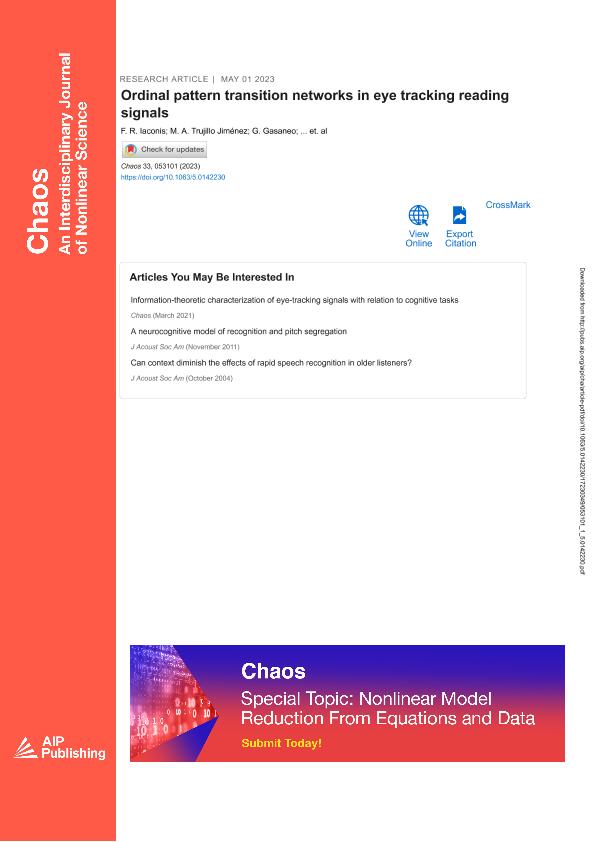Artículo
Ordinal pattern transition networks in eye tracking reading signals
Iaconis, Francisco Ramiro ; Trujillo Jiménez, Magda Alexandra
; Trujillo Jiménez, Magda Alexandra ; Gasaneo, Gustavo
; Gasaneo, Gustavo ; Rosso, O. A.; Delrieux, Claudio Augusto
; Rosso, O. A.; Delrieux, Claudio Augusto
 ; Trujillo Jiménez, Magda Alexandra
; Trujillo Jiménez, Magda Alexandra ; Gasaneo, Gustavo
; Gasaneo, Gustavo ; Rosso, O. A.; Delrieux, Claudio Augusto
; Rosso, O. A.; Delrieux, Claudio Augusto
Fecha de publicación:
05/2023
Editorial:
American Institute of Physics
Revista:
Chaos
ISSN:
1054-1500
Idioma:
Inglés
Tipo de recurso:
Artículo publicado
Clasificación temática:
Resumen
Eye tracking is an emerging technology with a wide spectrum of applications, including non-invasive neurocognitive diagnosis. An advantage of the use of eye trackers is in the improved assessment of indirect latent information about several aspects of the subjects' neurophysiology. The path to uncover and take advantage of the meaning and implications of this information, however, is still in its very early stages. In this work, we apply ordinal patterns transition networks as a means to identify subjects with dyslexia in simple text reading experiments. We registered the tracking signal of the eye movements of several subjects (either normal or with diagnosed dyslexia). The evolution of the left-to-right movement over time was analyzed using ordinal patterns, and the transitions between patterns were analyzed and characterized. The relative frequencies of these transitions were used as feature descriptors, with which a classifier was trained. The classifier is able to distinguish typically developed vs dyslexic subjects with almost 100% accuracy only analyzing the relative frequency of the eye movement transition from one particular permutation pattern (plain left to right) to four other patterns including itself. This characterization helps understand differences in the underlying cognitive behavior of these two groups of subjects and also paves the way to several other potentially fruitful analyses applied to other neurocognitive conditions and tests.
Palabras clave:
Machine Learning
,
Decision Theory
,
Eye tracking
,
Dyslexia
Archivos asociados
Licencia
Identificadores
Colecciones
Articulos (ICIC)
Articulos de INSTITUTO DE CS. E INGENIERIA DE LA COMPUTACION
Articulos de INSTITUTO DE CS. E INGENIERIA DE LA COMPUTACION
Articulos(IFLP)
Articulos de INST.DE FISICA LA PLATA
Articulos de INST.DE FISICA LA PLATA
Articulos(IPCSH)
Articulos de INSTITUTO PATAGONICO DE CIENCIAS SOCIALES Y HUMANAS
Articulos de INSTITUTO PATAGONICO DE CIENCIAS SOCIALES Y HUMANAS
Citación
Iaconis, Francisco Ramiro; Trujillo Jiménez, Magda Alexandra; Gasaneo, Gustavo; Rosso, O. A.; Delrieux, Claudio Augusto; Ordinal pattern transition networks in eye tracking reading signals; American Institute of Physics; Chaos; 33; 5; 5-2023; 1-7
Compartir
Altmétricas



